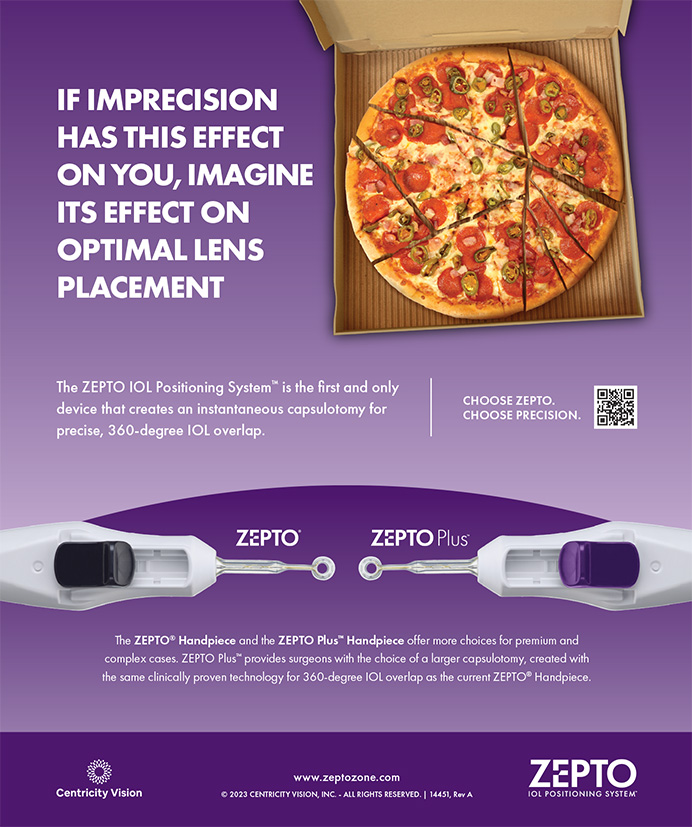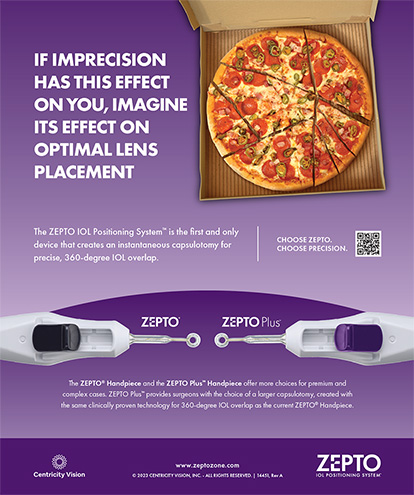As the popularity of refractive surgeries such as LASIK and PRK grows, surgeons will increasingly be confronted with the problem of calculating the proper IOL power after previous corneal refractive surgery. The difficulty of IOL power calculation after refractive surgery lies in the ability to accurately calculate corneal powers. The altered corneal shape can result in multiple ranges of corneal power throughout the central corneal surface. Conventional manual keratometry measures a limited number of points at a 3 to 4 mm annulus, which can vary with steeper or flatter corneal shapes. Another factor introduced by corneal tissue removing surgeries, such as LASIK, has been the change in the standardized refractive index of the cornea due to the change in the corneal power of the front corneal surface.
There are three basic techniques currently available for the calculation of proper IOL power: 1) the clinical history method, 2) the contact lens overrefraction method, and 3) computerized topographic data.
CLINICAL HISTORY METHOD
This method utilizes the patient’s preoperative information as well as a postoperative refraction to accurately calculate the corneal power. Preoperatively, corneal keratometry and manifest refraction data are needed, as well as a postoperative refraction. This can be an accurate method of assessing a patient’s actual change in corneal power, if all of this information can be provided. The obvious disadvantage is that most patients do not have access to their preoperative corneal or ocular measurements. A second disadvantage is that many patients do not present with a recent postoperative manifest refraction prior to the development of their cataract to obtain accurate measurements.
CONTACT LENS OVERREFRACTION METHOD
A hard contact lens of known base curve and power is fit to the operative eye. Adding the value of the contact lens overrefraction to these two known quantities gives us the sum of the refractive error and corneal power of the eye. Subtracting out the manifest refraction of the patient gives us the refractive corneal power. A disadvantage of this technique is the need for adequate visual acuity for an accurate overrefraction. Zeh and Koch1 studied this method in eyes with cataracts and normal corneas with visions as poor as 20/80. Above this level, these investigators found that the results were inaccurate due to poor visual acuities. Further study is needed for eyes treated with PRK or LASIK.
COMPUTERIZED TOPOGRAPHIC DATA
The average corneal power over the central 3 mm of the visual axis can be calculated utilizing a corneal topographer. If there is a range of corneal powers available, choosing the flattest effective keratometric value is advised, as this will help minimize the postoperative hyperopic shift. In a patient who has had previous incisional refractive surgery, simply finding this average corneal power is all that is necessary. However, in a patient who has had LASIK or PRK, the effective corneal power has to be modified due to the tissue removal and change in front surface corneal power. In a study carried out on LASIK patients, topographic keratometry data had to be reduced by a value of 15% times the change in refraction. If only manual keratometry data were available, the modifier was determined to be 20%. Therefore, the effective corneal power would be reduced by this factor multiplied by the change in correction. The use of keratometry data was less accurate than topographic data. Hugger et al found that multiplying the corneal keratometry change by a factor of 1.21 would equalize the change in a manifest refraction with a change in corneal keratometry.2 This study analyzed patients who had had previous PRK surgery.
TIPS FOR IOL POWER CALCULATION
Surgeons should try to select the flattest “K” value possible when calculating an IOL power in order to avoid a hyperopic shift. Patients who have undergone a previous radial keratotomy may exhibit postoperative hyperopic shift. In this situation, surgeons may need to wait up to 3 months for the refraction and topography to stabilize before considering whether to perform an IOL exchange or a piggy-back lens procedure. Keep in mind that proper patient education concerning the limitations of these formulas is imperative. The potential inaccuracy of IOL power necessitating additional lens surgery such as lens exchange or piggy-back lens implantation, is essential to take into account for successful surgical outcomes.
SUMMING IT UP
Each of these methods can help surgeons to more accurately select the proper IOL power for patients who have had previous corneal surgery. The most difficult challenge for refractive surgeons is that much of the data necessary are often not present because of the long time interval between a patient’s cataract surgery and refractive surgical procedure. A working knowledge of these three basic methods combined with trying to gather as much preoperative patient information as possible, will help surgeons overcome this problem, which will certainly grow in significance as the number of patients receiving refractive surgery increases worldwide. The first two methods, the clinical history method and hard contact lens overrefraction, can be used for incisional surgery as well as excimer laser surgery. Care must be taken with the topographic method when analyzing patients who have had previous PRK or LASIK due to a change in effective refractive corneal index of refraction. In the future, our ability to more accurately measure the corneal surfaces including the anterior and posterior curvature, as well as new IOL technologies that may allow for more surgeon customization, will help us improve the accuracy of this difficult postrefractive surgical situation.
Y. Ralph Chu, MD, is the Medical Director of the Chu Laser Eye Institute in Edina, Minnesota, and is a Clinical Assistant Professor of Ophthalmology at the University of Minnesota. Dr. Chu may be reached at (952) 835-0965; yrchu@chulasereye.com
1. Zeh W, Koch D: Comparison of contact lens overefraction and standard keratometry for measuring corneal curvature in eyes with lenticular opacity. J Cataract Refract Surg 25:898-903, 1999
2. Hugger P, Kohnen T, La Rosa F, et al: Manifest refraction and corneal power after photorefractive keratectomy. Am J Ophthalmol 129:68-75, 2000


